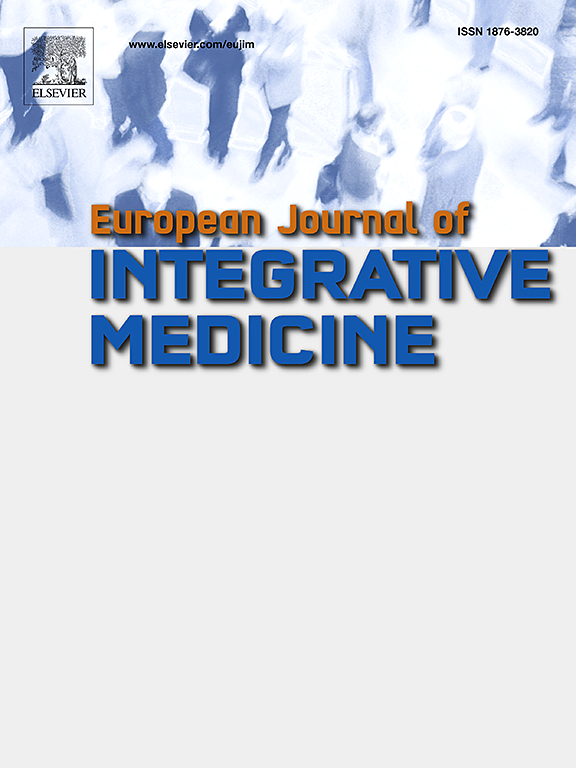Evaluation of acupuncture pain management guidelines based on the AGREE II tool
IF 1.7
4区 医学
Q3 INTEGRATIVE & COMPLEMENTARY MEDICINE
引用次数: 0
Abstract
Introduction
This study aimed to assess the methodological quality of clinical practice guidelines for acupuncture in pain management, with the goals of identifying areas requiring improvement and providing insights for the development of high-quality guidelines in the future.
Methods
Two researchers conducted an independent literature review and screening. The included guidelines were evaluated using the Appraisal of Guidelines for Research and Evaluation (AGREE II) Instrument. The literature search was performed across the following databases and websites: China National Knowledge Infrastructure (CNKI), Wanfang Data, China Science and Technology Journal Database (VIP), PubMed, Web of Science, Embase, National Institute for Health and Care Excellence (NICE), the New Zealand Ministry of Health website, SinoMed, and other relevant platforms. Six domains were assessed: Scope and Purpose, Stakeholder Involvement, Rigour of Development, Clarity of Presentation, Applicability, and Editorial Independence. SPSS 23.0 was employed to assess inter-rater reliability, calculate domain scores, and analyze the mean standardized percentage and standard deviation for each domain.
Results
A total of 19 guidelines were incorporated into the analysis, with an inter-rater reliability coefficient exceeding 0.75. These guidelines originated from China (n = 16, 84.2 %), South Korea (n = 2, 10.5 %), and the United Kingdom (n = 1, 5.3 %). Based on the AGREE II scores, five guidelines were rated as high-quality, 12 as average-quality, and two as low-quality. The scores for each domain were as follows: Scope and Purpose (76.46 % ± 4.07 %), Stakeholder Involvement (61.99 % ± 13.95 %), Rigour of Development (61.13 % ± 14.28 %), Clarity of Presentation (76.17 % ± 7.71 %), Applicability (31.36 % ± 11.88 %), and Editorial Independence (46.05 % ± 35.26 %).
Conclusion
The existing clinical practice guidelines for acupuncture in pain management remain limited in quantity and generally lack methodological rigour. Notably, significant deficiencies were observed in the domain of Applicability, indicating an urgent need for improvement in this area.
基于AGREE II工具的针刺疼痛管理指南评估
本研究旨在评估针灸疼痛管理临床实践指南的方法学质量,目的是确定需要改进的领域,并为未来高质量指南的制定提供见解。方法由两位研究者进行独立的文献回顾和筛选。使用研究和评估指南评估(AGREE II)工具对纳入的指南进行评估。通过以下数据库和网站进行文献检索:中国知网(CNKI)、万方数据、中国科技期刊数据库(VIP)、PubMed、Web of Science、Embase、国家卫生与保健卓越研究所(NICE)、新西兰卫生部网站、中国医学信息网(SinoMed)和其他相关平台。评估了六个领域:范围和目的、利益相关者参与、开发的严谨性、表述的清晰度、适用性和编辑独立性。采用SPSS 23.0统计软件评估评分者间信度,计算各域评分,分析各域的平均标准化百分比和标准差。结果共纳入19条指南,信度系数均大于0.75。这些指南来自中国(n = 16, 84.2%)、韩国(n = 2, 10.5%)和英国(n = 1, 5.3%)。基于AGREE II的分数,5个指南被评为高质量,12个为平均质量,2个为低质量。每个领域的得分如下:范围和目的(76.46%±4.07%),利益相关者参与(61.99%±13.95%),开发的严谨性(61.13%±14.28%),表达的清晰度(76.17%±7.71%),适用性(31.36%±11.88%)和编辑独立性(46.05%±35.26%)。结论现有针灸治疗疼痛的临床实践指南数量有限,且普遍缺乏方法学的严谨性。值得注意的是,在适用性方面观察到重大缺陷,表明迫切需要改进这一领域。
本文章由计算机程序翻译,如有差异,请以英文原文为准。
求助全文
约1分钟内获得全文
求助全文
来源期刊

European Journal of Integrative Medicine
INTEGRATIVE & COMPLEMENTARY MEDICINE-
CiteScore
4.70
自引率
4.00%
发文量
102
审稿时长
33 days
期刊介绍:
The European Journal of Integrative Medicine (EuJIM) considers manuscripts from a wide range of complementary and integrative health care disciplines, with a particular focus on whole systems approaches, public health, self management and traditional medical systems. The journal strives to connect conventional medicine and evidence based complementary medicine. We encourage submissions reporting research with relevance for integrative clinical practice and interprofessional education.
EuJIM aims to be of interest to both conventional and integrative audiences, including healthcare practitioners, researchers, health care organisations, educationalists, and all those who seek objective and critical information on integrative medicine. To achieve this aim EuJIM provides an innovative international and interdisciplinary platform linking researchers and clinicians.
The journal focuses primarily on original research articles including systematic reviews, randomized controlled trials, other clinical studies, qualitative, observational and epidemiological studies. In addition we welcome short reviews, opinion articles and contributions relating to health services and policy, health economics and psychology.
 求助内容:
求助内容: 应助结果提醒方式:
应助结果提醒方式:


